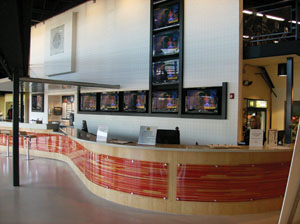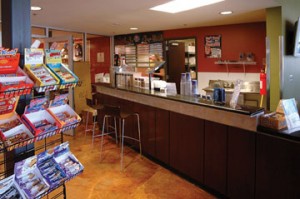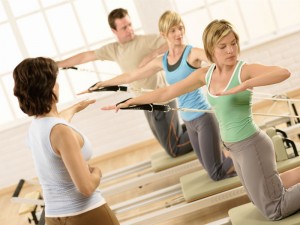The sales staff can bring members in one after another and attempt to sell more and more members all day. However, like the saying goes, it’s easier to keep a member than it is to get a new one. With that said, how can a club ensure more profits from those members than just the monthly fee? The answer is simple, but the task may take some minor ingenuity on the clubs behalf.
Adding extra profit centers within the club can boost membership ratings and make your club look like a one-stop shot for all things dealing with health, wellness and fitness. But, if a club implements the wrong type of profit center or pushes customers too hard, the profit center can flop and negate the desired results.
Take a good hard look at a few select areas that could potentially increase profits for your club. They could be anywhere from nutrition to Pilates classes and, if implemented precisely, could make a world of difference for the club’s bottom line.
 Nutrition: Juice Bars/Café/Supplements
Nutrition: Juice Bars/Café/Supplements
The best thing about implementing a form of nutrition within the club is its ability to help members gain amazing results following workouts. The difficult task, as many clubs have discovered, has been educating members and staff about the importance of nutrition.
Penfield Fitness in Rochester, N.Y. implemented a juice bar that is located at their front desk. Todd Shaw, the membership director, said the club gains about 5 percent revenue from the juice bar, but the crucial aspect was making his staff and members understand the importance of nutrition. “Nutrition is 60 to 80 percent the equation to reaching fitness goals,” said John Peters, the market director for Vitabot, an online private-labeled member nutrition tracking system for health clubs. “Nutrition completes the service — health clubs offering nutrition are offering the whole service to help members reach their goals.” Health clubs can offer Vitabot to their members as an upsell to personal training or the club can charge a small additional fee to members for online-nutritional guidance.
Shaw explained that the best place to start was with the trainers. The trainers have the most one-on-one time with the club’s members. The members listen to them for 30 minutes to an hour about different ways to exercise and get in shape. When the trainer brings up the idea of grabbing a shake to replenish muscles after a workout, the member will listen.
“Having highly educated trainers is important for long-term growth and success,” said Mike Akana, the VP of fitness at Gold’s Gym Birmingham. “Since we live in the age of information, people want a quick, cheap and convenient method of getting in shape.”
The next big step must include the rest of the staff. Hopefully, the trainers have been properly certified and understand a good deal of nutrition and different supplements. However, the workers at the front desk may not have the best insight into different types of supplements. “It is essential to have the group exercise instructors promoting our supplement line, our front desk educated on the products and even the kids club instructors selling children’s multivitamins, Akana said.”
Scott Fastino, the owner of General Fitness in Fall River, Mass., said the best thing a club could do is find a quality product that the club and its members can believe in. Fastino said the use of Met-Rx has been highly accepted by his clients and, as a company, Met-Rx has helped push their supplements in his club. “They will come in at least once a quarter and talk about supplements with the staff and members,” Fastino said. “They really help us out with samples and things of that nature.”
 Considering Penfield Fitness hosts their juice bar at the front desk, Shaw said it was crucial to teach the front desk employees everything about supplements and making shakes. “Controlling cost is a key component,” Shaw said. “When you use proper types of products and make sure everyone is trained, you won’t be losing money in products.”
Considering Penfield Fitness hosts their juice bar at the front desk, Shaw said it was crucial to teach the front desk employees everything about supplements and making shakes. “Controlling cost is a key component,” Shaw said. “When you use proper types of products and make sure everyone is trained, you won’t be losing money in products.”
Many clubs may believe the products to make the shakes and smoothies will cut into the club’s bottom line, but Shaw explained that clubs have a misconception concerning how much they need. “Clubs get these massive freezers and stack them with produce,” Shaw said. “They don’t need that much. You just need a small freezer full of produce to make the shakes. If the employees are trained properly they won’t go through the produce as fast.”
Shaw said Performance Food Centers has an online academy that employees can be put through to educate them on properly making nutrition. “The recipes are simple, about five components,” Shaw said. “It’s more or less teaching the person about the product and what it does for a member.”
Personal Training
For many clubs personal training is the largest profit center available. Also, by utilizing personal training properly, it can help the club gain major bucks from the nutritional standpoint. Regardless, if the club only implements training, members will begin to see results and a reputation can be established for the club.
According to Josh Bowen, the quality control director of personal training for Urban Active, there are three keys to the success of any personal training department: Knowledge, relationship building and salesmanship.
“Our trainers must have the knowledge base to deal with any client scenario they may encounter,” Bowen said. “A knowledgeable trainer can provide great client results through application of their ideas. Our Training Directors and Trainers must have the component of relationship building with our members and clients in order to be successful.”
Many personal training programs have gained ground with clients by bringing technology into the equation. “The addition of a mobile iPad and Web-based technology into the club’s training program will substantially enhance a trainers efficiency by allowing them to create, alter and log workouts in real time while training their client,” explained Stephen Esposito, the CEO of Technique Fitness. “The enhanced technology also allows trainers to report and review results with their clients, which leads to better client retention and longevity.”
Urban Active said they gain about 25 to 30 percent of the overall company revenue from personal training each year. “It has made an enormous impact on our business,” Bowen explained. “It has allowed us to expand quicker to areas we didn’t even consider five years ago.”
Many times it can be a good idea for the trainer to take the client into a group exercise room or somewhere else to have a solid session. However, the benefit of personal training in the club is the ability to showcase the talents of the training staff to all the members. “Teach your Training Directors how to sell personal training and sell it well,” Bowen said. “Adding the additional EFT draft and/or cash will allow you to grow your business by leaps and bounds.”
Members love their club for implementing new and inventive classes. Although, Pilates isn’t a new concept, to implement it within a health club is a big move. “Pilates equipment alone will not bring success to a facility, but rather a quality educated and informed staff is essential to the success of any business,” explained Carol Tricoche, the executive director for Full Solutions™ STOTT PILATES®. “We assist the facility in locating [Pilates] trained or certified instructors in the facilities area.”
Tricoche said the number one challenge among facilities that have a desire to use Pilates as a profit center is finding a reputable and successful instructor. However, by taking the time to find a great instructor, the classes will run smoother and the reaction from the members will be worth the effort. “We have found that facilities that bring Pilates training to their own location to train their key instructors tend to be the most successful,” Tricoche said. “Staffing is crucial and a facility that only has one or two instructors is at the mercy of the instructors’ schedule. A studio with multiple instructors is able to service members’ schedules and their individual needs which leads to greater profits all around.”
When hiring a reputable instructor the facility should use the interview process to investigate the instructor’s previous experience. “Do they have ample experience assisting facilities with implementation of Pilates programs,” asked Tricoche? “They should ask for testimonials.”
Many times Pilates is considered part of the group exercise format of a club and is valued into the cost of the membership. “However, Pilates equipment-training is fee-based and is treated as personal training, semi-private and small-group training,” said Tricoche. “If the facility is able to create a small dedicated space for their equipment-based studio, as small as 400 square feet, they tend to see higher profits than when sharing space with group exercise.
“A dedicated space allows the facility to offer Pilates equipment training, private, semi-private and small-group training during the peak primetime hours for the biggest return on their investment. If a studio has six instructors working part-time at 10 hours a week training a combination of groups, they have the capability of earning gross revenues of $190,000 per year. If each instructor increases to 15 hours a week the facility can experience an increase to $310,000 gross per year. Both scenarios are achievable with the right staff and dedicated studio space — a business within a business.” -CS









